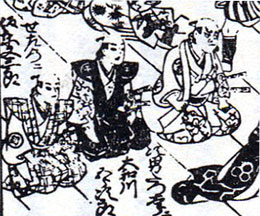| BANDď MATASABURď |
| TWO GENERATIONS | |||||
| Band˘ Matasabur˘ I Band˘ Matasabur˘ I |
|||||
|
Dates of birth and death unknown. Most likely a disciple of Band˘ Matajir˘ IV, he made his debut on stage in Edo at the Moritaza performing under the name of Band˘ Matasabur˘ I, as a wakashugata, in the kaomise drama "K˘bai no Momoyoguruma", which welcomed in Edo the actors Sakakiyama Sukegor˘, Osagawa Tatsuya and Sawamura Jűr˘zaemon. He became wakaonnagata and played at the Moritaza the role of the koshimoto Satsuki in the kaomise drama "Yorimasa Taikyoku no Mato". He went to Kamigata in 1716, became tachiyaku and performed in the kaomise drama "Ch˘ Hanagata Sangoku no Mukoiri", which was staged in the 12th lunar month of 1716 at the Naka no Shibai. He went back to Edo in Fall 1717, switched to wakaonnagata and performed at the Moritaza in Murase Genzabur˘'s kaomise drama "H˘n˘ Taiheiki". He went to Kamigata in 1722 and performed in the 6th lunar month of 1722 in ďsaka in the drama "Senri no Hama", which was staged at the Kado no Shibai. He went to Ky˘to in the 12th lunar month of 1722. He apperared in ˘shibai for the last time in the 1st lunar month of 1723 in Ky˘to, where he played the role of the kar˘ Sezaemon in the new year ni-no-kawari drama "Keisei Hitomaruzuka". From 1723, he perfomed exclusively in tabi shibai. His last-recorded performance happened in the 11th lunar month of 1731, in Nagoya at the Monzen-ch˘ no Shibai, where he performed with Sagawa Bunz˘ II, ďtani Hirohachi I and Asao Jűjir˘ I. His rank in the 1732 Nagoya hy˘banki, tachiyaku section, was j˘ (superior) [visual]. No record afterwards. |
|||||
 |
|||||
|
Band˘ Matasabur˘ I (left), Yamatogawa Gorojir˘ (center) and Ichikawa Takegor˘ (right) playing the roles of Sezaemon, S˘ry˘ Tatsutar˘ and S˘ry˘ Mantar˘ in the new year ni-no-kawari drama "Keisei Hitomaruzuka", which was staged in Ky˘to in the 1st lunar month of 1723 |
|||||
| Band˘ Matasabur˘ II Band˘ Matasabur˘ II |
|||||
|
Born in 1855. He was the son of Nakanishi Jűbŕ, a dekata at the Moritaza. He started his career at the beginning of the 1860s as a disciple of Band˘ Mitsugor˘ VI, who gave him the name of Band˘ Tamae. He took the names of Band˘ Mitsuemon II in 1881 and Band˘ Wak˘ in May 1895 at the Ryűseiza, a koshibai venue, where he made a fame for himself and earned the nicknamed Nisen Danshű. This expression could be translated as Tuppenny Danshű, Danshű being the haimy˘ of the Meiji star Ichikawa Danjűr˘ IX. Nisen meant two sen; the sen was one hundredth of a yen, which was the new currency created in Japan by the New Currency Act of 1871, to replace the complex monetary system of the Edo period. Nisen was two sen, the price of a ticket in T˘ky˘ koshibai. He became a disciple of Morita Kan'ya XII and took the name of Band˘ Matasabur˘ II in July 1897 at the Miyatoza, where he played the roles of ďboshi Yuranosuke and Makiyama J˘zaemon in the classic "Kanadehon Chűshingura". He had the chance to perform at the Kabukiza in August 1899 but the performance was not a success. He ended his career at the Miyatoza, where he was a mainstay. He died the 16th of February 1906.
|
|||||
|
|
| Contact | Main | Top | Updates | Actors | Plays | Playwrights | Programs | Links | FAQ | Glossary | Chronology | Illustrations | Prints | Characters | Derivatives | Theaters | Coming soon | News |